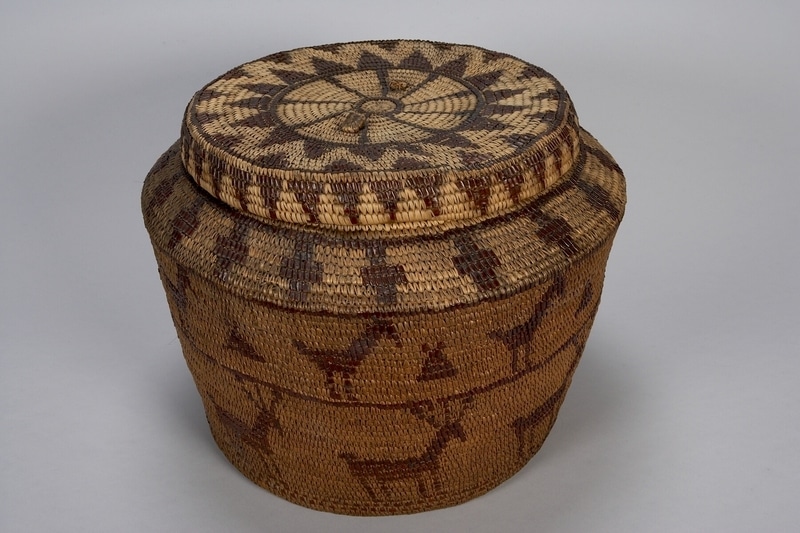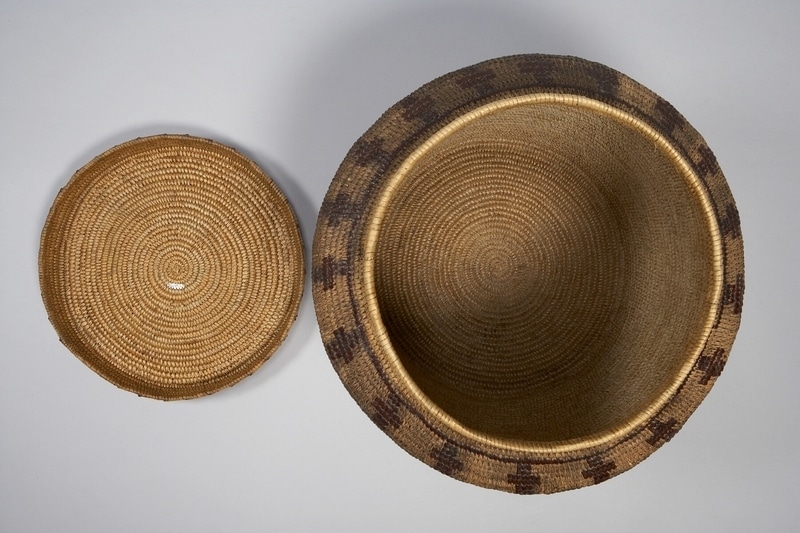Basket Item Number: Nd623 a-b from the MOA: University of British Columbia




Description
Coiled, tan, basket (part a) with bifurcated stitches; watch-spring base and lid (part b) construction. Basket is cylindrical in shape with a shoulder for the lid to rest upon. Both lid and body are partially imbricated. Bottom to top - two rows of beading; animal shapes with horns; single row of red imbrication; animal shapes alternating with triangles; single row of red imbrication; wide cross shapes; single row of red imbrication. The lid (part b) has a triangular design around the sides and along rim; starburst with spokes in center; all in red on cat-tail ground.
History Of Use
Storage basket. Coiled baskets in a range of sizes, embellished with distinctive patterns and motifs of animals and humans, have long been made and used by the Tsilhqot’in people. Spruce roots are usually preferred over cedar roots as the foundation for these strong and functional containers. Baskets were used extensively for carrying, storage and cooking, in addition to being made for trade or sale.
Specific Techniques
This type of basket was usually made of coiled split and bundled spruce-tree roots, stitched together by long, fine strands of spruce root. Beginning at the base of the basket, the weaver would gradually build up the form out of a continuous coil, stitching the upper layer to the coil below. Each stitch splits the one directly below it as the root is drawn through the coil. At the same time, the weaver folds or imbricates strands of grass and bark into each stitch on the outside of the basket, often creating dark patterns on a light background.
Item History
- Made in British Columbia, Canada before 1930
- Collected during 1900
- Owned by Margaret L. Buttimer
- Owned by Alfred J. Buttimer before 1932
- Received from Alfred J. Buttimer (Donor) during 1932
What
- Name
- Basket
- Identification Number
- Nd623 a-b
- Type of Item
- basket
- Material
- cedar root, cherry bark and cat-tail grass
- Manufacturing Technique
- coiled and imbricated
- Part A
- height 32.6 cm, diameter 46.4 cm
- Part B
- height 4.3 cm, diameter 35.8 cm
Who
- Culture
- Tsilhqot'in
- Previous Owner
- Margaret L. Buttimer and Alfred J. Buttimer
- Received from
- Alfred J. Buttimer (Donor)
Where
- Holding Institution
- MOA: University of British Columbia
- Made in
- British Columbia, Canada
When
- Creation Date
- before 1930
- Collection Date
- during 1900
- Ownership Date
- before 1932
- Acquisition Date
- during 1932
Other
- Item Classes
- basketry
- Condition
- good
- Current Location
- Case 30
- Accession Number
- 2003/0040 a-b